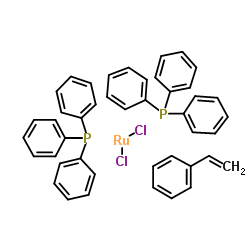254972-49-1
| Name | [1,3-bis(2,4,6-trimethylphenyl)imidazol-2-ylidene]-dichloro-(3-phenylinden-1-ylidene)ruthenium,tricyclohexylphosphane |
|---|---|
| Synonyms |
Dichloro(1,3-dimesityl-1,3-dihydro-2H-imidazol-2-ylidene)(3-phenyl-1H-inden-1-ylidene)ruthenium - tricyclohexylphosphine (1:1)
Phosphine, tricyclohexyl-, compd. with dichloro[1,3-dihydro-1,3-bis(2,4,6-trimethylphenyl)-2H-imidazol-2-ylidene](3-phenyl-1H-inden-1-ylidene)ruthenium (1:1) |
| Molecular Formula | C54H67Cl2N2PRu |
|---|---|
| Molecular Weight | 947.073 |
| Exact Mass | 946.346252 |
| PSA | 23.45000 |
| LogP | 16.24680 |
|
Section 1: Product Identification Tricyclohexylphosphine[1,3-bis(2,4,6-trimethylphenyl)imidazol-2-ylidene][3-phenyl-1H-inden-1-ylidene]rutheniu Chemical Name: m (II) dichloride, min. 95% [catMETium® RF1] CAS Registry Number:254972-49-1 Formula:RuCl2[C21H24N2][C15H10][P(C6H11)3] EINECS Number:none
Chemical Family:organometallic complexes Synonym:catMETium® IMesPCy Section 2: Composition and Information on Ingredients IngredientCAS NumberPercentACGIH (TWA)OSHA (PEL) Title compound254972-49-1100%no datano data Section 3: Hazards Identification Emergency Overview:Irritating to skin, eyes and respiratory tract. Primary Routes of Exposure:Ingestion, inhalation, skin, eyes Eye Contact:Causes irritation to eyes Skin Contact:Causes irritation to skin Inhalation:Irritating to the nose, mucous membranes and respiratory tract. Ingestion:No information available on the physiological effects of ingestion. May be harmful if swallowed. Acute Health Affects:Irritating to skin, eyes and respiratory tract. Chronic Health Affects:No information on long-term chronic effects. NTP:No IARC:No OSHA:No SECTION 4: First Aid Measures Immediately flush the eyes with copious amounts of water for at least 10-15 minutes. A victim may need Eye Exposure: assistance in keeping their eye lids open. Get immediate medical attention. Wash the affected area with water. Remove contaminated clothes if necessary. Seek medical assistance if Skin Exposure: irritation persists. Remove the victim to fresh air. Closely monitor the victim for signs of respiratory problems, such as difficulty Inhalation: in breathing, coughing, wheezing, or pain. In such cases seek immediate medical assistance. Seek medical attention immediately. Keep the victim calm. Give the victim water (only if conscious). Induce Ingestion: vomiting only if directed by medical personnel. SECTION 5: Fire Fighting Measures Flash Point:none Autoignition Temperature:none Explosion Limits:none Extinguishing Medium:carbon dioxide, dry powder or foam If this product is involved in a fire, fire fighters should be equipped with a NIOSH approved positive pressure Special Fire Fighting Procedures: self-contained breathing apparatus and full protective clothing. Hazardous Combustion andIf involved in a fire this material may emit irritating organic fumes. Decomposion Products: Unusual Fire or Explosion Hazards: No unusual fire or explosion hazards. SECTION 6: Accidental Release Measures Small spills can be mixed with vermiculite, sodium carbonate or other suitable non-combustible adsorbent and Spill and Leak Procedures: swept up. SECTION 7: Handling and Storage Handling and Storage:Store the material in a tightly sealed container in a cool, dry place. SECTION 8: Exposure Controls and Personal Protection Eye Protection:Always wear approved safety glasses when handling a chemical substance in the laboratory. Skin Protection:Wear protective clothing and gloves. Ventilation:Handle the material in an efficient fume hood. If ventilation is not available a respirator should be worn. The use of respirators requires a Respirator Respirator: Protection Program to be in compliance with 29 CFR 1910.134. Ventilation:Handle the material in an efficient fume hood. Additional Protection:No additional protection required. SECTION 9: Physical and Chemical Properties Color and Form:orange to brown powder Molecular Weight:947.07 Melting Point:no data Boiling Point:no data Vapor Pressure:no data Specific Gravity:no data Odor:not determined Solubility in Water:insoluble SECTION 10: Stability and Reactivity Stability:air and moisture stable Hazardous Polymerization:no hazardous polymerization Conditions to Avoid:none Incompatibility:strong oxidizing agents Decomposition Products:carbon dioxide, hydrogen chloride, carbon monoxide, organic fumes, phosphorus oxides, ruthenium oxide. SECTION 11: Toxicological Information RTECS Data:No information available in the RTECS files. Carcinogenic Effects:No data Mutagenic Effects:No data Tetratogenic Effects:No data SECTION 12: Ecological Information Ecological Information:No information available SECTION 13: Disposal Considerations Disposal:Dispose of according to local, state and federal regulations. SECTION 14: Transportation Shipping Name (CFR):Non-hazardous Hazard Class (CFR):NA Additional Hazard Class (CFR):NA Packaging Group (CFR):NA UN ID Number (CFR):NA Shipping Name (IATA):Non-hazardous Hazard Class (IATA):NA Additional Hazard Class (IATA):NA Packaging Group (IATA):NA UN ID Number (IATA):NA SECTION 15: Regulatory Information TSCA:Not listed in the TSCA inventory SARA (Title 313):Title compound not listed Second Ingredient:none SECTION 16 - ADDITIONAL INFORMATION N/A |
| Risk Phrases | 36/37/38 |
|---|---|
| Safety Phrases | 26-36/37/39 |
|
~79% 
254972-49-1 |
| Literature: Puentener, Kurt; Scalone, Michelangelo Patent: US2006/241156 A1, 2006 ; Location in patent: Page/Page column 6 ; |
| Precursor 2 | |
|---|---|
| DownStream 0 | |

